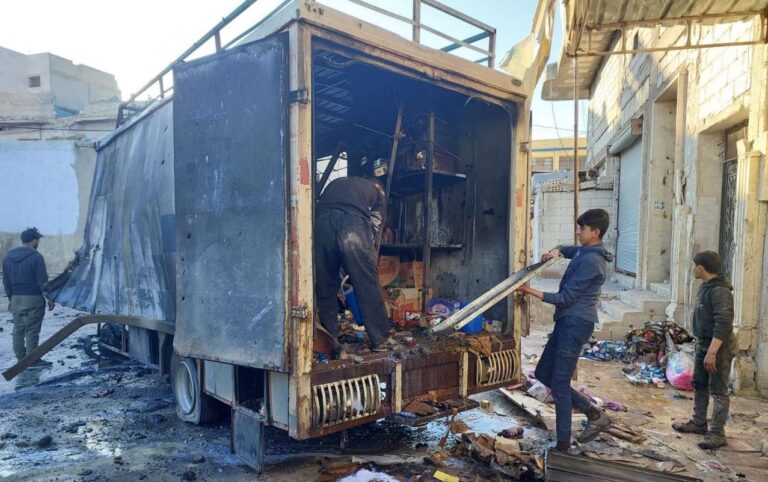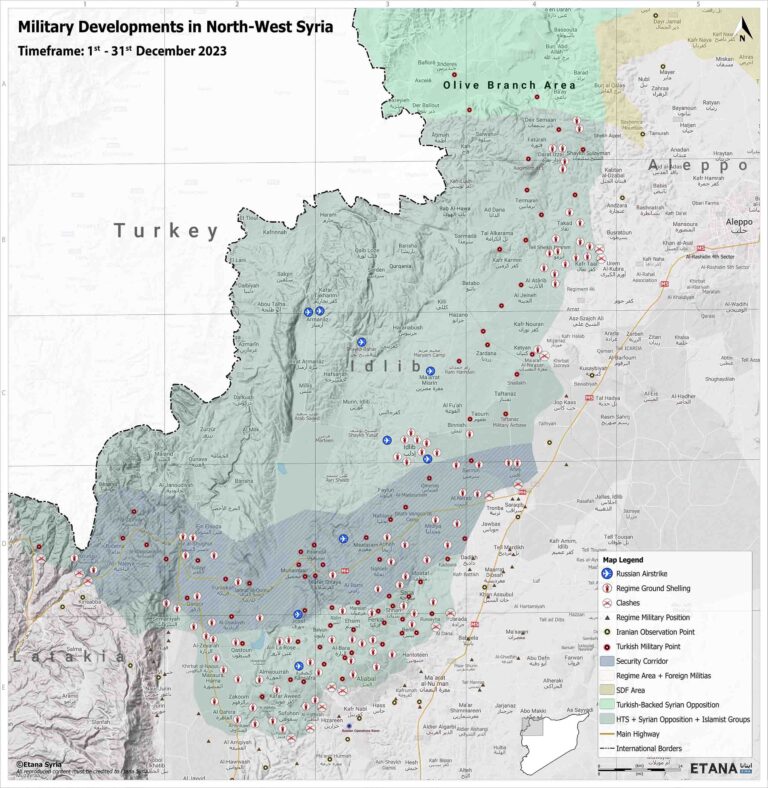The growing divisions within Hay’at Tahrir al-Sham (HTS) burst into clear view in recent weeks, greatly weakening the stature of the group in north-west Syria and coinciding with its increasing isolation and abandonment by former allies within the Turkish-backed Syrian National Army (SNA). Abu Ahmad al-Zakour, the former right-man man of HTS leader Abu Muhammad al-Jolani, formally split from the group and escaped to Turkish/SNA-controlled Afrin. This, combined with al-Zakour’s ambitions to lead a rival group, prompted HTS to mobilize for a military operation in Afrin. However, Turkish-backed forces swiftly deployed tanks at key crossings to thwart an impending HTS attack, thereby blocking roads and forcing HTS into a humiliating climbdown in the process. December was also a particularly deadly month for civilians in north-west Syria, with regime and Russian bombardments killing more than 30 people and injuring at least 103 others.
Attached Map:
Military Developments in North-West Syria
(For a high-resolution version of this map, please use the form at the bottom of the page)
HTS Divisions & Factional Developments
After weeks of uncertainty, the formal defection of key Hay’at Tahrir al-Sham (HTS) insider Abu Ahmad al-Zakour is now beyond any doubt. Amid a campaign of arrests that HTS has kept up across Idlib since late last year, al-Zakour fled to Turkish-controlled Afrin where he is reportedly seeking Ankara’s support to form a new rival armed group. To restore its reputation and demonstrate strength in the face of these damaging developments, HTS mobilized forces to attack Afrin. However, Turkish forces were evidently prepared for such a move, swiftly blocking two key crossings that link the Afrin countryside with HTS-held areas further south, sending a clear message to HTS that any attack would be met with a harsh response.
Russian & Regime Activity
The regime and its allies sustained a renewed campaign of bombardment across north-west Syria that first escalated in November, striking dozens of towns and cities across Aleppo, Idlib and Latakia with rocket attacks and artillery barrages. In early January, regime forces also carried out attacks on the eastern outskirts of Idlib city using internationally prohibited cluster munitions armed with incendiary materials. Civilian casualties have been high: collectively, December’s attacks killed at least 30 people and injured more than 103—although this number of wounded is believed to be a significant undercount. A large proportion of the casualties were women and children.
Russia also continued its bombardment campaign over north-west Syria in the latter half of December, launching airstrikes against several towns that killed at least five civilians. Iranian-backed militias have also begun to play a larger role in the ongoing assault against opposition-held areas of the north-west, targeting largely civilian sites with several barrages of suicide drone attacks.
Opposition & Radical Group Activity
The hardline Fateh al-Mabin regularly shelled pro-regime positions with barrages of artillery as well as rockets last month, with hits recorded around the western Aleppo countryside, southern Idlib countryside and northern Latakia countryside. Fateh al-Mabin snipers also recorded hits against a total of 16 pro-regime troops in southern Idlib’s countryside.







